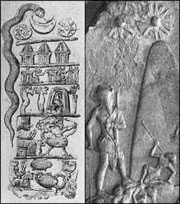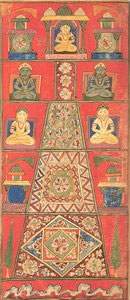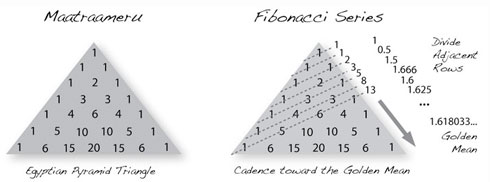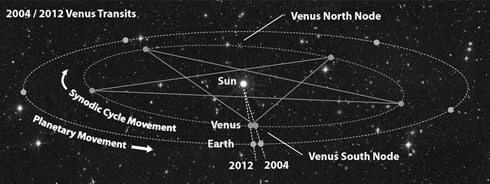To begin, there are three celestial deity lineages that are based on the astronomical relationship between the Sun, Venus and Moon. The Sun lineage, represented by Indra, Dumuzi, Tammuz, Dionysus, Bacchus (the ‘Green Man’) and Jesus, are all gods of wine, intoxication and the garden (more on this here). The Venus lineage, represented by Vena/Shukra, Inanna, Ishtar, Astarte, Asherah, Aphrodite, Venus and Mary/Meriam, are all goddesses of fertility. Another feminine lineage having to do with the Moon and death is represented by Kali, Ereshkigal, Persephone/ Kore, Proserpina and Mary Magdaline of Magdala (or Indian Magadha empire). The two feminine lineages were typically taken together as lightness-darkness or fertility-death, even combined in Italy as the two Biblical Marys, while the male lineage was taken as a father-son or god-man duality.
Sumerian Shamash (sun), Sin (moon) and Ishtar (Venus) hover over the mountain.
 All three lineages are described and illustrated together over a mountain described in Sumerian tablets and the Hindu Vedas at least as early as 3000 BCE. This mountain is named Mount Sumeru or Meru and is described as a supernal bridge or ladder extending from deep under the Earth’s oceans up into space with the summit representing a heaven filled with gold.
All three lineages are described and illustrated together over a mountain described in Sumerian tablets and the Hindu Vedas at least as early as 3000 BCE. This mountain is named Mount Sumeru or Meru and is described as a supernal bridge or ladder extending from deep under the Earth’s oceans up into space with the summit representing a heaven filled with gold.
5-tier Mount Meru from the Jain Agamas.
 It was within this structure that the pantheon of all the other gods lived and danced. Along its central axis, the Axis Mundi, lived serpent deities called ‘asuras’ which Venus or ‘Asherah’ ruled over. As the celestial archetype for the Rod of Asclepius, Staff of Moses, Staff of Hermes and medical Caduceus, the serpents spiraling around the axis of Meru symbolized the natural Fibonacci spiral converging around a pyramid or Egyptian triangle to the golden ratio. This is described by Pingala perhaps as far back as 450 BC, as explained in http://www.cs.okstate.edu/~subhashk/GoldenMean.pdf
It was within this structure that the pantheon of all the other gods lived and danced. Along its central axis, the Axis Mundi, lived serpent deities called ‘asuras’ which Venus or ‘Asherah’ ruled over. As the celestial archetype for the Rod of Asclepius, Staff of Moses, Staff of Hermes and medical Caduceus, the serpents spiraling around the axis of Meru symbolized the natural Fibonacci spiral converging around a pyramid or Egyptian triangle to the golden ratio. This is described by Pingala perhaps as far back as 450 BC, as explained in http://www.cs.okstate.edu/~subhashk/GoldenMean.pdf
Fibonacci series f(n) = f(n-1) + f(n-2) = 1 1 2 3 5 8 13 21 34 55 89 144 …
Fibonacci converging (or ascending) to the golden ratio, golden mean or ‘divine proportion’ represented by the Greek letter Phi or Φ:

Meru model based on Fibonacci series.
This theoretical mountain became the gold-paved heaven prototype atop all sacred mountains, such as Mount Olympus, Mount Sinai and Mount Moriah / Zion. It was also the universal template for temple building used around the world. Common to the Meru temple model is the number five. Babylonian ziggurats were built in five levels after depictions of this five-level mountain on a Uruk tablet, c3000 BC. Hindu funeral pyres are built similarly in five levels as is the King’s Chamber in the Great Pyramid of Egypt. Depictions of Mount Meru in the Jain Agamas parallel diagrams in Babylonia, showing five levels. The importance of five can be explained by the golden ratio Phi being derived from five in the Fibonacci series or more compactly as Φ = (sqrt(5) + 1) / 2.
Thus, we find the golden ratio to lie at the heart of ancient religion. But, this is not simply due to a sequencing property of numbers. The planet Venus actually approximates the golden ratio over an 8-year period by retrograding and facing the Earth exactly five times to form a pentacle in the night sky. This is due to the fact that Venus orbits the sun thirteen times for every eight orbits of the Earth, creating the Fibonacci ratio 13:8 = 1.625, which is very close to the golden ratio Φ.
This 8-year Venusian cycle was symbolized in ancient Sumer as an 8-point star. This same idea was portrayed in Egyptian hieroglyphs as a 5-points star or pentacle where it meant ‘rising upwards toward the point of origin’ and formed part of words such as ‘to bring up,’ ‘to educate,’ and ‘the teacher.’ (Cirlot, p. 310). Thus, the Venus pentacle was a symbol of enlightenment and knowledge in ancient times, translated into Latin as ‘Lucifer’, the light bringer. As a symbol of the sacred feminine and the golden ratio – found in every intersection of a pentagram – this was the prime knowledge of nature at the heart of all pre-Christian religions. Unfortunately, it was considered pagan and thus suppressed by the Church and forbidden in the Christian Bible (e.g., the Tree of Knowledge and Apple of Knowledge).

8-year Venus cycle creating a pentacle with Earth.
To suppress knowledge of a divine constant at work in nature, the Church had to also suppress the feminine fertility aspect of God as represented by Venus. In its place, the Jesus deity became a kind of super Green Man – a new kind of solar deity powerful enough to inherit both male and female attributes. While the lineage of male deities all follow the celestial pattern of the Sun’s death – beneath The Crux constellation on the Winter solstice, then resurrected three days later on December 25th under the constellation of The Three Kings – this birth-rebirth concept actually seems to have been first introduced through the Sumerian Venus deity Inanna:
‘Fascinating is the account of Inanna’s descent into ‘the land without return’, kur-nu-gi-a, a dry, dusty place, situated below the sweet waters of the earth. She decided to visit this dark realm, which belonged to her enemy and sister goddess, Ereshkigal, ‘the mistress of death’, and assert her own authority there. Having adorned herself with all her finery and left behind Ninshubur, her Vizier, with orders to rescue her should she not return, Inanna descended to kur-nu-gi-a. At each of its seven portals she was obliged to take off a garment or ornament, until at last she appeared naked before Ereshkigal and the seven judges of the dead. ‘At their cruel command, the defenceless goddess was turned into a corpse, which was hung on a stake.’ After three days and nights had passed … They obtained access to Inanna’s corpse and resurrected it with the ‘food of life’ and the ‘water of life’.’ — Oxford Dictionary of World Mythology.
For those who might still doubt the ancients could have discovered the ‘divine proportion’ in the orbital pattern of Venus and founded their religions on it, consider that Omen texts from the First Babylonian Dynasty (c. 1900-1660 BC) confirm that the old Mesopotamian sky watchers understood that Venus as the morning star and the evening star were the same thing. By the Seleucid period (c. 301-164 BC), we have a number of late goal-year texts in which the 8-year period was used to predict the appearances of Venus. These texts are clay tablets that list astronomical data for a given year and also for years specified by adding an appropriate number to the starting year. For Venus, the number to be added is eight. Accordingly, the pattern in the table for Venus will work for every eighth year from the year for which the table is prepared.
One text from the Neo-Babylonian period (626-539 BC), referring to Venus as Dilbat, records ‘Dilbat 8 years behind thee come back … 4 days thou shall subtract.’ Here, the Mesopotamian planet watcher is instructed to subtract four days to get the right date for Venus. Another much older text called the Tablets of Ammizaduga, inscribed around 1700-1600 BC, provide 21 years of Venus data, including dates of first and last appearances as a morning star and as an evening star along with durations of invisibility. It says:
‘If on the 25th of Tammuz Venus disappeared in the west, for 7 days remaining absent in the sky, and on the 2nd of Ab Venus was seen in the east, there will be rains in the land; desolation will be wrought. (year8)’ – E. C. Krupp, Echoes of the Ancient Skies: The Astronomy of Lost Civilizations
Despite scribal errors, the texts clearly exhibit the 8-year Venus cycle and indicate Mesopotamians in the middle of the second millennium BC were aware of it. And, having tracked the path of Venus so meticulously, they would have certainly observed the five retrograde pauses and connected the dots, so to speak, to form the pentacle and discover the divine proportion in its intersections.
Comparing this to the sacred Mayan Tzolkin calendar, based on the 260-day Venus cycle, we find the same 13:8=1.625 proportion discovered by the Babylonians:
260-day Tzolkin cycle * 5 Venus retrogrades = 1300 days
1300 days / 8-year Venus cycle = 162.5 days
 Whether discovered separately or shared through ancient trans-Atlantic voyages, the pentagonal orbit of Venus and the golden mean hidden within it was the founding principle in all of the world religions. Reflected in the geometries of flowers, seed patterns in fruit and the human anatomy, the pentacle was proof of a divine order in Nature. No advanced mathematics is needed – just careful observation and a little simple arithmetic was enough to reveal God to our ancestors. While few today are in the least bit aware of it, the celestial harmony between the Sun, Venus and Earth-Moon system is the first and true religion – everything else is a mythical veneer.
Whether discovered separately or shared through ancient trans-Atlantic voyages, the pentagonal orbit of Venus and the golden mean hidden within it was the founding principle in all of the world religions. Reflected in the geometries of flowers, seed patterns in fruit and the human anatomy, the pentacle was proof of a divine order in Nature. No advanced mathematics is needed – just careful observation and a little simple arithmetic was enough to reveal God to our ancestors. While few today are in the least bit aware of it, the celestial harmony between the Sun, Venus and Earth-Moon system is the first and true religion – everything else is a mythical veneer.









